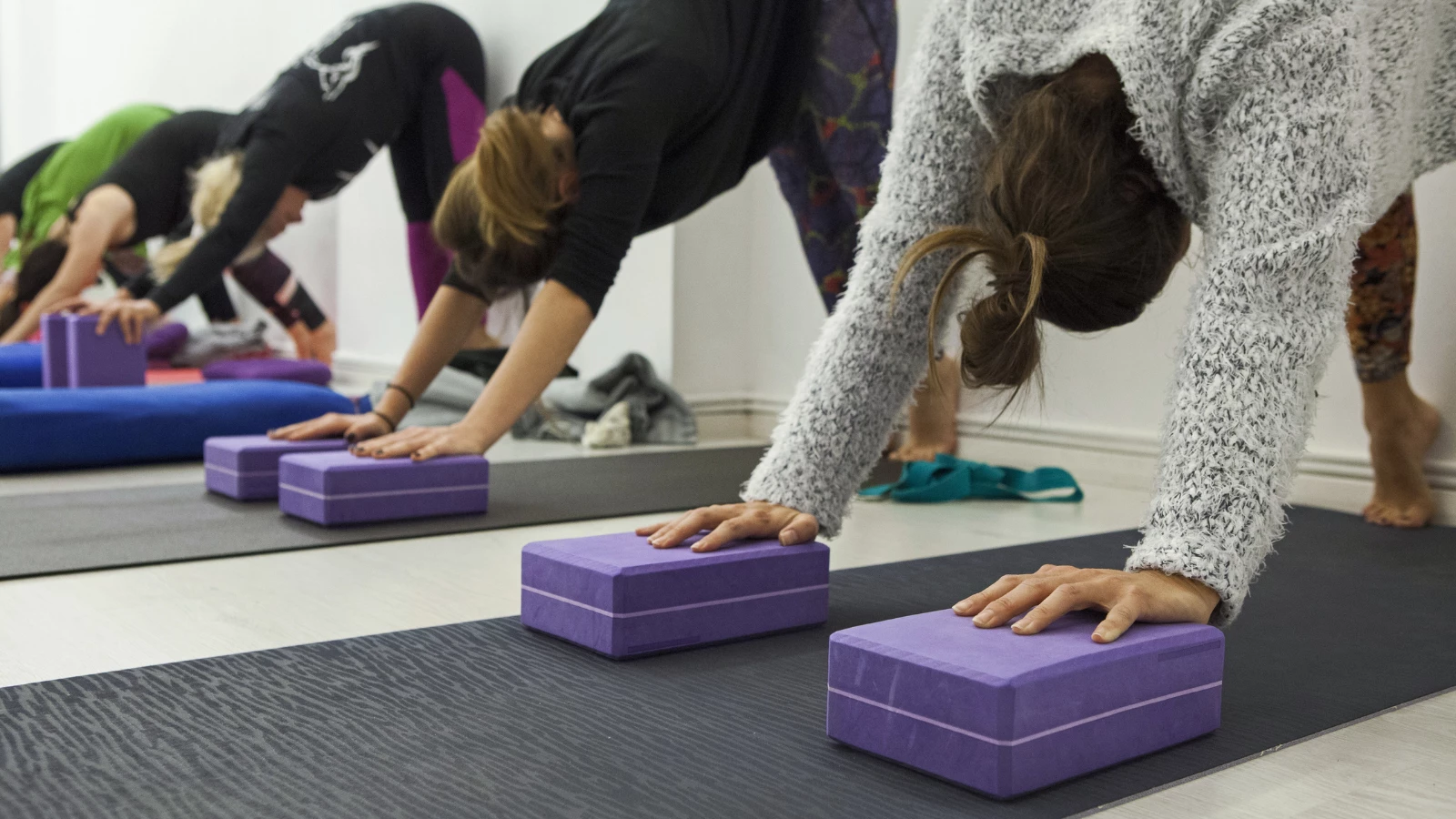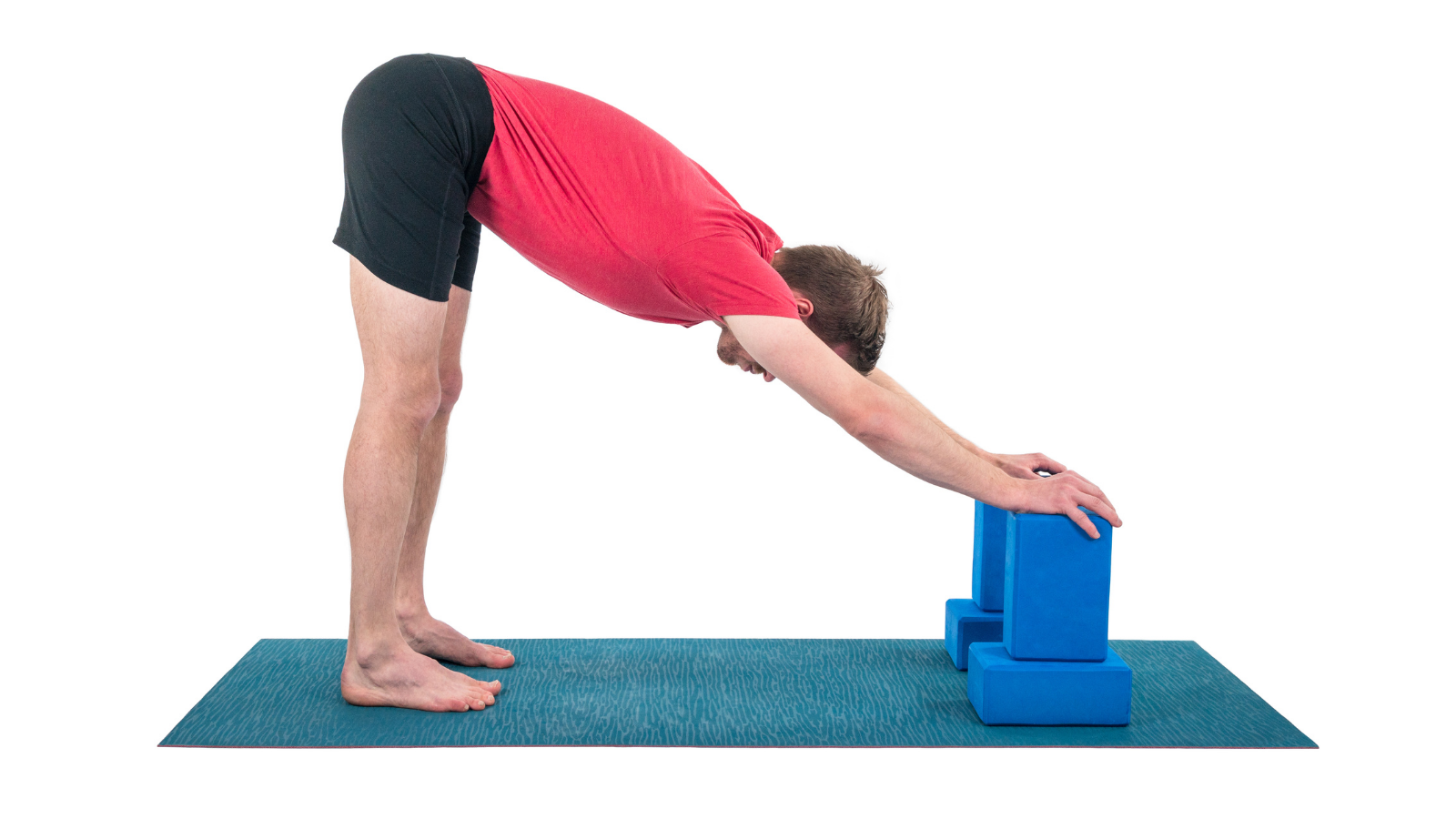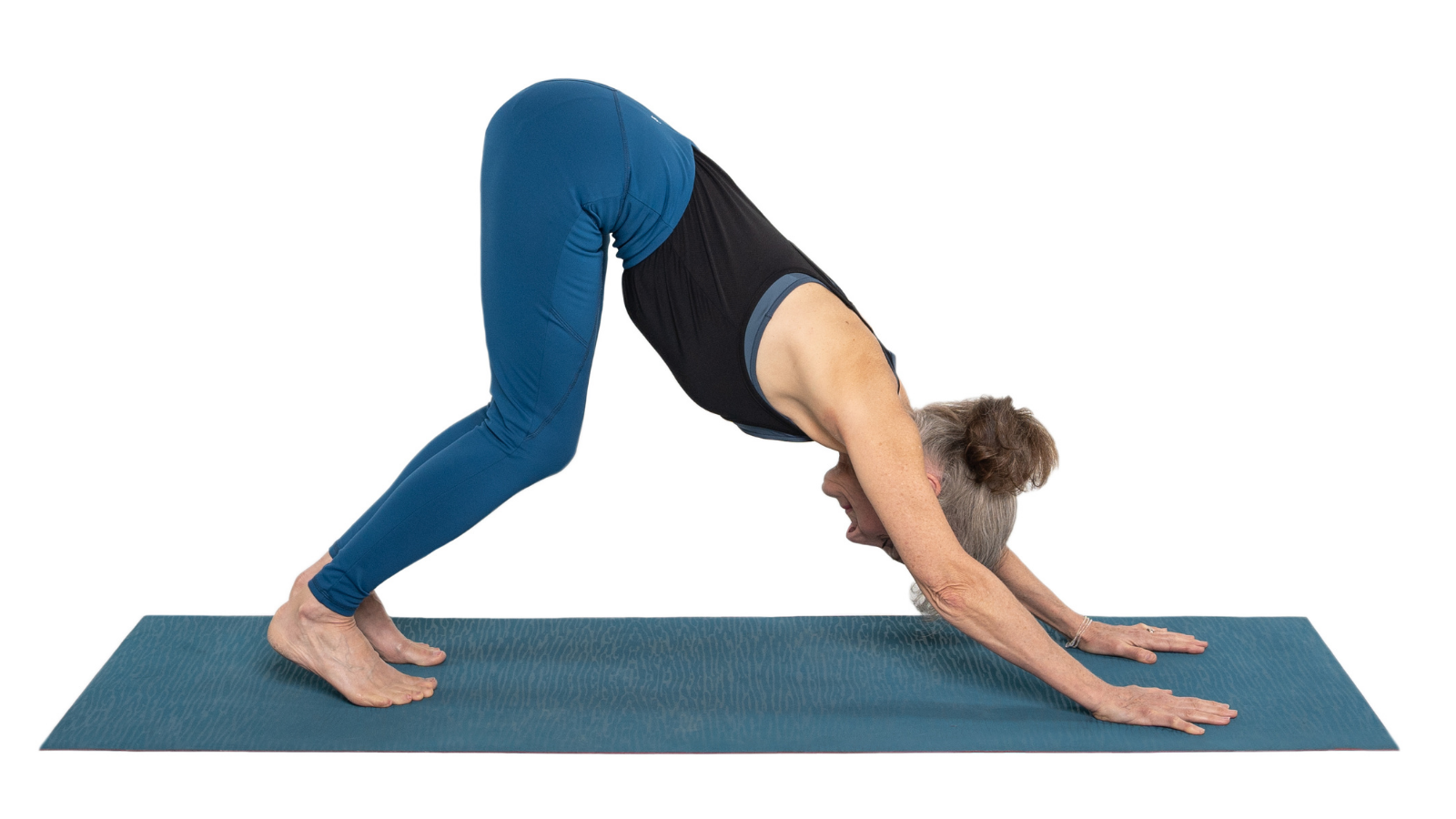How to Calm the “Belly Brain”
Downward Facing Dog Pose with Tias Little

Article At A Glance
How can Downward Facing Dog Pose (Adho Mukha Svanasana) calm a racing mind? Tias Little shares here his top trick for calming the “belly brain.”
We live in a world where being busy can be associated with one’s worth. Day-to-day, we may be constantly caught between obligations to work, family, friends. We may be left with little time for our own physical and mental health between our many commitments. A 90-minute yoga practice may seem like a luxury most of us can’t afford on a daily basis.
But what if we could attain the calming benefits of yoga in a few minutes or less? Renowned yoga teacher Tias Little believes we can. And in fact, it may be possible to still the mind in just a few breaths, as he shows us in this short video.
Supporting the Belly Brain in Downward Facing Dog Pose
 As Tias teaches us, adding a prop to support the head in Downward Facing Dog Pose can pacify the entire body. Why? The magic of this practice has to do with what Tias calls the “belly brain.”
As Tias teaches us, adding a prop to support the head in Downward Facing Dog Pose can pacify the entire body. Why? The magic of this practice has to do with what Tias calls the “belly brain.”
“We correlate the cranial brain with the belly brain, so we let the cranial brain be supported on a prop,” Tias explains here.
The “belly brain,” otherwise known as the enteric nervous system (ENS), is a network of 100 to 500 million neurons in our digestive tract. The ENS is capable of sending messages throughout the entire gastrointestinal tract independently of the central nervous system. The enteric nervous system is also noteworthy because it connects with the brain via the vagus nerve. Known for its role in regulating the sympathetic (fight-or-flight) and parasympathetic (rest-and-digest) nervous systems, the vagus nerve connects the brainstem to the thorax and abdomen. In doing so, the vagus nerve instructs the digestive system to speed up gut motility when we’re relaxed or slow it down when we perceive danger.
Unfortunately, the body can overreact to stressors that aren’t actually life-threatening, such as traffic jams or impending work deadlines. Even non-threatening stressors like these can trigger activation of the sympathetic nervous system. Over time, sympathetic nervous system activation can be especially damaging if we lack outlets to discharge its effects. Chronic stress can majorly impact the health of both the “belly brain” and the body as a whole. This can contribute to or aggravate digestive issues including irritable bowel disease, food allergies, and gastroesophageal reflux disease (GERD).
Easing Stress by Stimulating the Vagus Nerve in Downward Facing Dog

The good news is stress-induced damage to both the digestive system and the body as a whole is often reversible. And mind-body practices including yoga, meditation, and tai chi can help. The brain-gut axis is key to the effects of mindfulness-based practices on digestive health. By bringing our bodies and minds into an environment that promotes a sense of safety and ease, we encourage the mind to quiet. This signals activation of the parasympathetic nervous system. Working via the vagus nerve, the brain signals digestion to function.
And when we incorporate certain yogic breathing exercises, such as the diaphragmatic breathing Tias teaches us here, we can directly stimulate the vagus nerve, triggering further relaxation response to occur. Over time these practices may contribute to lessening the severity of symptoms of digestive ailments, such as abdominal pain, heartburn, diarrhea, constipation, and bloating.
The Benefits of Being Upside Down in Downward Facing Dog for the Belly Brain and Beyond
 Inversions are powerful yogic practices that can also dampen the effects of stress. Many yogic practitioners find going upside down to be soothing, balancing, and to slow the chattering of the mind. Downward Facing Dog Pose is one of the best inversions to practice and teach because it is more accessible than certain inversions like Handstand (Adho Mukha Vrksasana), Headstand (Sirsasana), or Shoulder Stand (Sarvangasana). As a forward bend, Downward Facing Dog is also thought to induce relaxation by stimulating the parasympathetic nerves that originate in the brainstem and sacrum.
Inversions are powerful yogic practices that can also dampen the effects of stress. Many yogic practitioners find going upside down to be soothing, balancing, and to slow the chattering of the mind. Downward Facing Dog Pose is one of the best inversions to practice and teach because it is more accessible than certain inversions like Handstand (Adho Mukha Vrksasana), Headstand (Sirsasana), or Shoulder Stand (Sarvangasana). As a forward bend, Downward Facing Dog is also thought to induce relaxation by stimulating the parasympathetic nerves that originate in the brainstem and sacrum.
There are countless variations of Downward Facing Dog that can make the benefits of this posture accessible to differing levels of ability. For example, students with high blood pressure, glaucoma, or are in the second or third trimester of pregnancy, deep inversions are not advisable. Instead, the head can come closer to level with the heart by practicing Downward Facing Dog at a wall. Tias offers us another variation of Downward Dog in this video, instructing us to place a bolster under our heads to encourage a quieting of the mind.
A Downward Facing Dog Pose Practice to Calm the Mind
To soothe an anxious mind in Downward Facing Dog, practice along with Tias’s video above. His guidance is outlined in the steps below:
- Come onto all fours, Tabletop Pose (Bharmanasana), with a blanket under your knees. Position a bolster on your mat horizontally to support your head when you come into Downward Facing Dog. You can place a folded blanket over the bolster approximately under your navel for added cushion.
- Orient the top of your forehead on top of the bolster. The bolster should be firm enough so that your head doesn’t sink into the prop like cotton candy. If your bolster is too soft, switch to a firmer bolster or place yoga blocks under your bolster.
- Come into Downward Facing Dog Pose with your head on the bolster. Widen your stance so your feet come to mats-width apart to broaden your abdominal region, passively spreading your organs and back.
- Invite the muscles of your face and ears to subtly soften as you stay in this shape. Breath in and out through your nose, allowing the belly to inflate and soften with each breath. After several belly breaths, release the pose, returning to all fours.
Also, read...
Warrior I Pose: 5 Strengthening Variations
Jul 02 – Bridget Frederick, eRYT 500
4 Easy Ways to Use a Sandbag in Yoga Practice
Jun 18 – Jennifer Williams-Fields E-RYT 200
Exercise and Longevity: Diversify Your Yoga Practice for Maximum Benefits
Jun 10 – Kathryn Boland, R-CYT, R-DMT
Related courses
Breath as Medicine: Yogic Breathing for Vital Aging
With Doug Keller
Yoga and Myofascial Release: Releasing Chronic Tension with the Bodymind Ballwork Method
With Ellen Saltonstall

Lacey Ramirez writes for YogaUOnline and is an RYT-500 & ERYT-200 yoga teacher, global health researcher, and writer based in St. Louis. Through her work, she seeks to make yoga accessible, inclusive, and equitable.
Lacey discovered yoga as a tool for centering during her years as a competitive runner. Since then, yoga has served as a way to connect with her body throughout her experience of pregnancy and parenthood. She teaches because she hopes others can use this sacred practice for calming, healing, and transformation.
As a yoga teacher, Lacey specializes in teaching restorative, Yin, prenatal, and trauma-informed Vinyasa yoga. She has also completed birth doula and prenatal/postnatal barre certifications and trainings. Additionally, she holds a Masters of Science in Global Health and Population from Harvard T.H. Chan School of Public Health. To learn more and connect, visit her website laceyramirez.com
Recent articles
Warrior I Pose: 5 Strengthening Variations
Jul 02 – Bridget Frederick, eRYT 500
4 Ways to Practice Locust Pose
Jun 26 – Baxter Bell, MD, eRYT 500, C-IAYT
The Yoga Sutras: Practicing Non-Attachment without Becoming Detached
Jun 24 – By: Tracy Weber, C-IAYT, E-RYT 500
Categories
Upcoming courses
Breath as Medicine: Yogic Breathing for Vital Aging
With Doug Keller
Yoga and Myofascial Release: Releasing Chronic Tension with the Bodymind Ballwork Method
With Ellen Saltonstall
JOIN NOW!
Recent articles
Almost there...
Sorry, we couldn't find anything...
Yoga Practice Tips
Warrior I Pose: 5 Strengthening Variations
Warrior I Pose (Virabhadrasana I) is an excellent pose for strengthening your whole back…
Jul 02 – Bridget Frederick, eRYT 500
Pose Library
4 Ways to Practice Locust Pose
Locust Pose (Salabhasana) is a simple backbend that strengthens the entire back of your…
Jun 26 – Baxter Bell, MD, eRYT 500, C-IAYT
Beginning Yoga
The Yoga Sutras: Practicing Non-Attachment without Becoming Detached
The concepts of attachment and non-attachment are mentioned several times in The Yoga Sutras…
Jun 24 – By: Tracy Weber, C-IAYT, E-RYT 500



